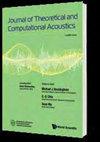运动水下声源诱发声波的谱元模拟
IF 1
3区 物理与天体物理
Q3 ACOUSTICS
Journal of Theoretical and Computational Acoustics
Pub Date : 2019-10-15
DOI:10.1142/S2591728518500408
引用次数: 1
摘要
在这项研究中,我们基于谱元法(SEM)模拟了三维水下环境中移动声源引起的声波。利用便于流固耦合和吸收边界条件的SEM软件包SPECFEM3D_Cartesian进行数值实验。本文给出的例子包括利用吸收边界截断的无界流体,以及基于域分解的流固耦合系统建模的浅水波导。在数值实验中,sem计算的压力与分析结果相匹配。模拟运动声源前后点压力的SEM解呈现频移,即多普勒效应,与解析解相吻合。本文对基于被动声呐的运动声源探测领域做出了贡献,并解决了通过使用连续信号的运动声源计算侧扫声纳产生的波响应的挑战。本文章由计算机程序翻译,如有差异,请以英文原文为准。
Spectral-Element Simulations of Acoustic Waves Induced by a Moving Underwater Source
In this study, we model acoustic waves induced by moving acoustic sources in three-dimensional (3D) underwater settings based on a spectral-element method (SEM). Numerical experiments are conducted using the SEM software package SPECFEM3D_Cartesian, which facilitates fluid–solid coupling and absorbing boundary conditions. Examples presented in this paper include an unbounded fluid truncated by using absorbing boundaries, and a shallow-water waveguide modeled as a fluid–solid coupled system based on domain decomposition. In the numerical experiments, the SEM-computed pressures match their analytical counterparts. SEM solutions of pressures at points behind and ahead of modeled moving acoustic sources show a frequency shift, i.e., a Doppler effect, which matches the analytical solution. This paper contributes to the field of passive sonar-based detection of moving acoustic sources, and addresses the challenge of computing wave responses generated by side-scan sonar by using moving sources of continuous signals.
求助全文
通过发布文献求助,成功后即可免费获取论文全文。
去求助
来源期刊

Journal of Theoretical and Computational Acoustics
Computer Science-Computer Science Applications
CiteScore
2.90
自引率
42.10%
发文量
26
期刊介绍:
The aim of this journal is to provide an international forum for the dissemination of the state-of-the-art information in the field of Computational Acoustics.
Topics covered by this journal include research and tutorial contributions in OCEAN ACOUSTICS (a subject of active research in relation with sonar detection and the design of noiseless ships), SEISMO-ACOUSTICS (of concern to earthquake science and engineering, and also to those doing underground prospection like searching for petroleum), AEROACOUSTICS (which includes the analysis of noise created by aircraft), COMPUTATIONAL METHODS, and SUPERCOMPUTING. In addition to the traditional issues and problems in computational methods, the journal also considers theoretical research acoustics papers which lead to large-scale scientific computations.
 求助内容:
求助内容: 应助结果提醒方式:
应助结果提醒方式:


